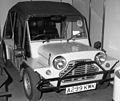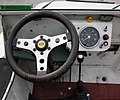Mini Moke
| Austin , Morris , BLMC | |
|---|---|
| Mini moke | |
| Production period: | 1964-1993 |
| Class : | Small car |
| Body versions : | Beach wagon |
| Engines: |
Petrol engines : 0.85–1.3 liters (25.4–57.6 kW) |
| Length: | 3041 mm |
| Width: | 1361 mm |
| Height: | 1473 mm |
| Wheelbase : | 2020 mm |
| Empty weight : | 600 kg |
The Mini Moke is a vehicle based on the Mini and was designed by Alec Issigonis for the British Motor Corporation (BMC). The name comes from the "Mini" - the car with which the Moke has a lot in common, and "moke", an outdated British slang for "donkey".
The initial design was a prototype called a buckboard , which was used to test the mechanical components of the mini while driving. Later, a light military vehicle in the style of the American jeep was developed from it, which, however, could not be used as an off-road vehicle due to its small wheels and low ground clearance .
As a result, it was offered in a civil version as a utility vehicle with low costs and easy maintainability.
The Moke finally achieved its success as an alternative to the VW buggy - as a popular cult vehicle in Australia, France, the United States and in many tropical holiday resorts.
The original Moke used the same engine, gearbox and suspension as the Mini, and the B in the chassis numbers ( A A B = A ustin; M A B = M orris) of the English variants is due to its buckboard origins.
Moke versions
Prototypes
In 1959, 7 prototypes of the Moke were built, recognizable among other things by the typical mini location of the tank and battery in the rear. One of this series (chassis number: SPL 466) hangs in the Haynes Motor Museum, in Sparkford, Somerset .
In 1962, a model from the 1959 series was converted to the Twinny (with two drive units). The additional motor in the rear drove the rear wheels. At the same time, a second row was launched, in which the battery and the tank were now (as with the Twinny and the later series models) attached to the side between the axles. This row also had a convertible top and indicators.
In 1962 Mokes with a shorter wheelbase and a simplified body were also produced, which were tested by the Rhodesian Army and already had the MK1 series seats. In 1964 (at the same time as the start of series production) the idea of the Twinnys was taken up again, this time with specially made bodies, which otherwise corresponded to the now officially available MK1 series.
In Australia , some four-wheel drive single-engine mokes were built in the late 1970s , but production in Sydney never reached market maturity.
British Moke 1964–1968
After the sale of the Moke to the military did not work out, the decision was made in 1963 to build a civil version for commercial applications. When the car was presented in 1964, due to sales tax, it was decided to sell it as a car and not as a truck as intended.
All Mokes were delivered with an 848 cm³ engine, passenger seats, grab handles, heating, windscreen washer, hood and windscreen wipers for the passenger side could be ordered as special equipment. However, all extras had to be attached by yourself.
The Mark I Moke had a single windshield wiper and a floor-mounted high beam switch. The only color available was green.
In 1967 the Mark II Moke came, it had a front passenger windscreen wiper and the high beam switch was combined with the directional switch, these Mokes were also available in white.
A total of 14,518 Mokes were built in England, 90% of which were exported.
African moke 1964-1967
Approximately 300 Mark I Mokes, exported as Completely Knocked Down (CKD) kits , were assembled in the town of Umtali , Rhodesia / Zimbabwe .
These were numbered on a separate label next to the chassis number. It says ASSEMBLED IN RHODESIA BODY No. XXX .
Australian moke 1966–1982
From 1966 Mokes (also: BMC YDO7 / YDO18 ) were also manufactured in Sydney, and in 1968 the entire production was relocated to Australia.
Initially, the Mokes were built with 10 "wheels, later they got 13" wheels because of the greater ground clearance. This included a modified rear panel and longer rear axle swing arms in combination with an additional rim around the wheel arches. The metal seats were exchanged for seats which consist of a welded tubular frame with suspension. This variant initially had a 998 cm³ engine, later it was changed to 1098 cm³, and in 1976 the 998 cm³ engine was used again because of the emissions standard in Australia.
As factory extras there were roll bars, headlight grilles, studded tires and side covers.
In 1972 the Californian model with a 1275 cc engine was built for the American market. In 1975 there was a pick-up version with a 1.45 m × 1.50 m loading area. In 1976, when the second edition of the Californian model came out, you could even order a radio and metallic paint. From 1979 Mokes were delivered with a body made of Zintec sheet metal, roll bar, larger tank, different top and again changed seats.
A total of 26,142 Mokes were produced in Australia.
Portuguese moke 1980–1990
When production in Australia came to an end, production was relocated to British Leyland Motor Corporation in Vendas Novas , Portugal . Approx. 8500 units were built there, initially with 13 "wheels, then from 1986 with 12" wheels in order to be able to use more standard parts of the Mini.
As extras there were aluminum rims, oil pan protection, spare wheel covers and a hardtop.
Cagiva Moke 1990-1993
The Italian motorcycle manufacturer Cagiva bought the manufacturing equipment for the Moke from the MG Rover Group in 1990 , and it continued to be manufactured in Portugal until 1993 . When tools and machines were brought to Bologna ( Italy ), Mokes were to be produced there again from 1995, but this never happened. Cagiva only made about 1500 mokes.
A total of 49,937 Mokes were built. The English company M-Parts later bought up all the spare parts that were still available, as well as the presses and molds, and has since been producing repair and original sheets again.
Original preservation
Many mokes are no longer in their original condition, which is due to the short construction times and the low number of pieces of the individual models. The manufacturing processes did not provide for rust prevention. Many parts of the mini can also be used on the moke, which makes it seldom original state of preservation.
popularity
A Mini Moke was featured in the James Bond film Live and Let Die . James Bond heads for a yacht and gets out.
In the Bond films You Only Live Twice , The Spy Who Loved Me, and Moonraker , the Moke was used as a cargo carrier in each villain's headquarters.
In the English television series number 6 (Original title: The Prisoner ) Mokes drove as a taxi through the city.
In the television series Die 2 , Tony Curtis drives off the runway to the sea in episode 02 ( business with Napoleon ) and in episode 20 ( the hunt for the formula ) a Moke plays along as a rocket.
Also starring in some films are Louis de Funès , Balduin, der Ferienschreck ( Les grandes vacances ), Fantomas versus Interpol ( Fantômas contre Interpol ), Everything dances to my tune ( L'homme orchester ) and Louis and his crazy policemen ( Le Gendarme et les Gendarmettes ) Mokes with.
In the Love Story More - more - always more ( More ) by Barbet Schroeder and in the film The Collector ( La Collectionneuse ) there is also a Moke, also in the Franco-Italian comedy Pack the tiger on the tail ( Le diable par la queue ) and in the film Brutale Stadt ( Città violenta ) by Sergio Sollima , furthermore in the films by Georges Lautner Take it easy, take dynamite (Ne nous fâchons pas) and A girl like the sea ( La grande sauterelle ).
In the low-budget film series Carry on… the film Das totally verrückte Campingparadies ( Carry on Camping ) features the same Moke as in episode 6-26 The Gas Light Killer Club of the television series With Umbrella, Charm and Melon ( The Avengers ).
A yellow moke plays an important role in the 1969 comedy film Twelve Plus One with Vittorio Gassman and Sharon Tate .
The cover of the record "Best of" by Dave Dee, Dozy, Beaky, Mick & Tich showed the band on a mini moke. Only at second glance does it become apparent that something is wrong with the picture: Obviously, the record was made for the European market. So that the steering wheel can be seen on the "correct" side, the image was simply mirrored (recognizable by the missing fuel cap on the left and the three covers). The tank was always on the left on all models with a tank on the side, regardless of whether it was right or left-hand drive, and the storage compartments or the battery were always on the right.
On the cover of Brigitte Bardot “La Madrague” you can see her with dogs in her green MK1 Austin Mini Moke. You can also see her with this Moke in “Spécial Bardot”, a TV film from 1968.
During his time in Edam (from 1971) the Dutch photographer Ed van der Elsken owned a green Mini Moke, which found its way into his photos and films.
Replicas
There were various replicas of the Moke, but optically they break new ground and sometimes only have the idea (open body made of many straight sheets) of the Moke and are technically based on the Mini. Many of these replicas were made using tubular frames .
"China" -Moke, kit car
In 2007 a company from England had Moke Kit Cars manufactured in China ; These are easy to recognize by the lack of beads on the inner sheet metal and an external sill between the wheel arches. The sheets cannot be combined with the original Moke (without significant processing).
"EMK6" -Moke, electric car since 2012
Since 2012 a company from southern France has been building electric mokes under the name eMK6 based on the China Mokes, these have 15 kW motor power and reach a top speed of 85 km / h. However, this model can only be delivered as a 2-seater. The price for such a moke is 22,500 euros.
"Thailand" -Moke, since 2014
In 2014 a Moke replica appeared in Thailand at the Thai Motor Expo in Bangkok, it has a slightly wider radiator grille and a 1-liter gasoline engine with 34 kW (50 PS).
Moke and tourism
The Moke was very popular as a beach buggy on the island states of Seychelles , Barbados and Mauritius .
Mini Mokes were rented to tourists on many Greek islands, at that time tourist rental cars had no air conditioning, so the Moke was very popular. After production of the Mini Moke was discontinued, the last vehicles were withdrawn from the rental car market in the mid-1990s.
Mokes were still rented to tourists in Macau until 2006 , but this was no longer possible due to new safety regulations.
Mokes can still be rented today (as of 2016) on the small Australian island of Magnetic Island .















